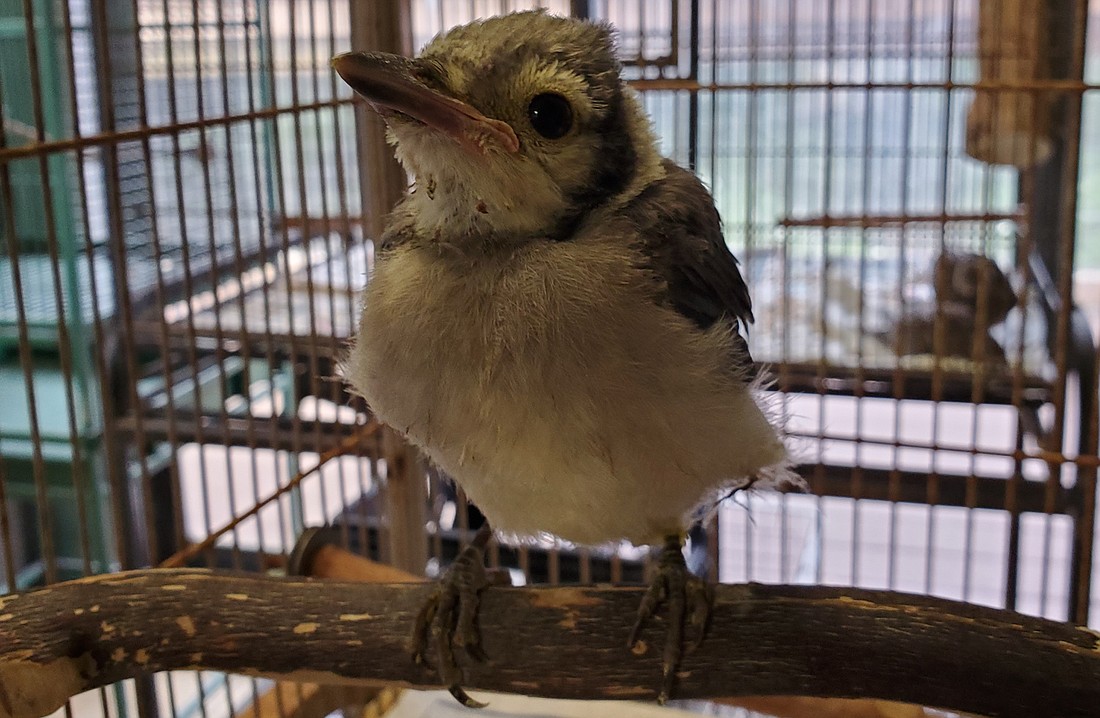- April 26, 2024
-
-
Loading

Loading

Lisa Laufenberg was walking along Greenbrook Boulevard May 28 when she spotted a baby blue jay that was struggling in the grass.
Laufenberg scanned the surrounding area for a nest or parent without any luck.
She wondered if she could help. Her mind raced between taking action and letting nature run its course. She knew baby birds require very particular care, so she would have to be committed to the task if she wanted to try to save the bird.
She decided to do her best to keep the bird alive.
More than a month later, because of Laufenberg’s actions, the blue jay is thriving. After rescuing the bird, Laufenberg took it to Save Our Seabirds, a wild bird education and rescue center on Sarasota’s City Island.
Save Our Seabirds Operations Manager Jocelyn Shearer said it appears the bird was born in early to mid-May. Its flight feathers will grow in soon, and then the bird will be moved to the larger aviary to make sure it’s a strong flier. Most birds only require a week in the aviary before they can be released into the wild.
Shearer said Laufenberg did a good job in the time between rescuing the bird and transporting it to Save Our Seabirds. The first thing Laufenberg did was pick the bird up. Shearer said a lot of people mistakenly believe if a person touches a bird, its parent won’t take it back. This is an old wives’ tale.
When Laufenberg picked up the bird, she noticed its body was cool. She hoped her hands would warm it up, and later placed it in a box with a towel, setting the box in her garage because it’s the warmest room in her house.
Shearer said Laufenberg’s choices in this case were good ones. Injured birds should be placed in a setting as warm, dark and quiet as possible. They should also be handled as little as possible.
“Let's say they've hit a window and they’re stunned,” Shearer said. “It might take them a day or two to recover. If people are petting them, it would be like if you were paralyzed and then there's a giant predator playing with you.”
Laufenberg researched what she should feed the bird and made a mixture of sugar water and canned cat food as soupy as she could, using a syringe to insert it into the bird’s mouth.
Shearer said she doesn’t recommend people feed birds, even baby ones that need constant nutrition, unless they’re being talked through it by experts at bird rescues or similar organizations. Feeding a bird can sometimes do more harm than good.
“We've had instances of people — they have a good heart, and they have good intentions — but they'll find a little bird that's abandoned, and then they'll start feeding it,” Shearer said. “They'll feed it something inappropriate. Then three days later, they'll be kind of tired of it chirping at them, and they'll bring it to us and now it's in poor health.”
While grocery shopping, Laufenberg ran into a friend who suggested she take the bird to Save Our Seabirds. Shearer said Wildlife Inc., an education and rehabilitation center in Bradenton Beach, might be closer to some East County residents.
Laufenberg said she was glad her friend recommended Save Our Seabirds.
“(Shearer) gently suggested that they had more experience and probably would have better luck with this baby bird than I did, which makes total sense,” Laufenberg said.